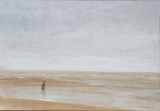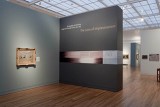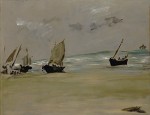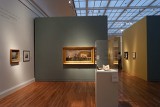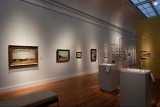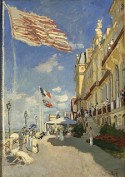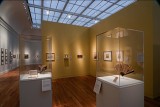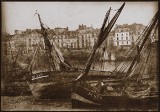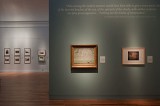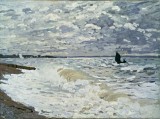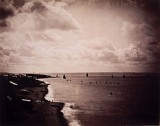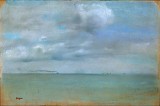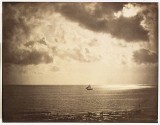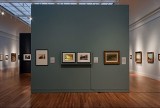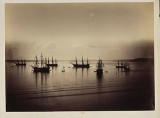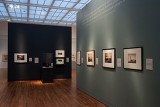The browser will either open the file, download it, or display a dialog.
The Lens of Impressionism: Photography and Painting along the Normandy Coast, 1850–1874
University of Michigan Museum of Art
10 October 2009 – 3 January 2010
Dallas Museum of Art
21 February 2010 – 23 May 2010
Catalogue:
The Lens of Impressionism: Photography and Painting along the Normandy Coast, 1850–1874
Carole McNamara, with essays by Sylvie Aubenas, Stephen Bann, Dominique de Font-Réaulx, and Dean MacCannell.
University of Michigan Museum of Art, Ann Arbor, in association with Hudson Hills Press, Manchester and New York, 2010.
208 pages; color and b/w illus; checklist of exhibition; bibliography; index
$50.00
ISBN: 978-1-55595-325-6
The seminal importance of Impressionism within the modernist narrative is, of course, an idée recue in approaches to the history of nineteenth-century painting. Recent years, however, have seen increasing debate regarding the origins of the radical formal and iconographical strategies associated with the movement. Such debates have explored the significance of traditional Western sources (particularly the Old Master tradition), non-Western sources (particularly Japanese prints) and the impact of new technologies (particularly the railroad and the camera). This exhibition enters this debate and argues for the crucial role of early photography in inspiring both Impressionist iconography, but also, and more emphatically, Impressionist style and particularly its strategies of asymmetry, cropping and the blurring of motion. Such an argument is not novel, and was first articulated in detail several decades ago by Aaron Scharf.[1] This exhibition, however, offers a new focus in concentrating on photographs and paintings of motifs on the Normandy Coast. The show is chronologically framed by the years of 1850, when artists first began photographing in Normandy, and 1874, when the first Impressionist exhibition was held. Curator Carole McNamara has put together a thoughtful and engaging show which explores the dialogue between photography and painting in a range of coastal locations and argues for the overriding importance of the coast (rather than, say, the city of Paris) in engendering, in the words of the introductory text panel, "an essential shift in a way of seeing and of expressing the landscape on canvas."
The Lens of Impressionism is the third exhibition in the University of Michigan Museum of Art's new wing, designed by Brad Cloepfil. The show has been several years in the making, having grown from an initial focus on the museum's own James McNeill Whistler view of the Trouville coastline, Sea and Rain (1865), and a desire to understand the motivations behind the production of this work (fig. 1). Recent years have seen a number of exhibitions relating to the Normandy Coast, building on earlier literature such as that by Robert Herbert.[2] This exhibition, however, is the first to be numerically dominated by photographs, a fact that is also reflected in the inclusion of photography before painting in the exhibition title, upsetting the more traditional hierarchical placement of these two art forms. Thus, there are 49 photographs in addition to 23 paintings by noted artists, such as Claude Monet and Edouard Manet, and less well-known figures, such as Eugène Le Poittevin and Jules-Achille Noël. McNamara has bolstered her argument for the importance of the Normandy Coast as a crucible for Impressionist formal experimentation by a valuable collaboration with the Bibliothèque Nationale. As a result, the show contains many fascinating photographs—many of which are shown here in the United States for the first time—by little-known photographers, such as Eugène Colliau, Auguste Autin, and the frères Macaire. There is a also a substantial selection of the much better known marine output of Gustave Le Gray who produced the most undeniably spectacular photographic views of the coast.
The exhibition is tastefully installed in shades of light and dark blue, yellow and gray, which seem to mimic the maritime theme of the exhibition, referencing shades of sea, sky and sand. Since there are no separate rooms, the trajectory of the exhibition is, however, at times, slightly confusing. The exhibition opens with a wall devoted to the single image of Edouard Manet's The Beach at Berck (1873) (fig. 2). With a few rapidly applied brushmarks, Manet represents a group of fishing boats beneath scudding clouds (fig. 3). His ability to capture this transient scene is emblematic, as the exhibition argues, of the kind of effect of instantaneity—or in McNamara's words, the "aesthetic of the instant"—that Impressionist painters developed in response to the example of early photographers.
The first section of the exhibition is entitled "The Romantic View" and briefly sets the scene by exploring representations of the coast in the early part of the century by artists, such as Eugène Isabey and Richard Parkes Bonington, who focused on picturesque fishing villages, generally avoiding an iconography of modernity. The show then examines views of the coast following the transformative arrival of the railroad on the coast at Le Havre in 1847 (and its subsequent extension along the Normandy Coast), making it possible for Parisians to easily reach the shore over a weekend. The focus here is on a few locations that rapidly expanded at mid-century in response to the rise of tourism. Among these was Étretat, which attracted tourists largely on account of its unusual cliff formations. The photographic representation of this site is dominated in the exhibition by Louis-Alphone Davanne whose willingness to record this expanding town is contrasted with Gustave Courbet's views, which generally scrupulously screened out all signs of modernity (fig. 4). This section of the show also includes Eugène Le Poittevin's large Bathing at Étretat (1866), which highlights the new tourist vogue for bathing; swimmers, overseen by an instructor, ascend a platform in order to dive into the ocean. This work, from the Musée des Beaux-Arts, Troyes, has often been reproduced in recent literature but rarely included in exhibitions; this is a rare opportunity for viewing by an American audience. The section on Étretat is also improved by the inclusion of a vitrine with early tourist literature, emphasizing the broader visual culture beyond painting and photography.
The exhibition continues with a section exploring representations of the resorts of Trouville and Deauville (fig. 5). Eugène Boudin perhaps of all artists in the 1860s was most associated with representations of the Normandy coast and regularly showed views of Trouville and Deauville at the Salon in the 1860s. His Bathing Time at Deauville (1865) is characteristic of such work, showing a group of tourists alongside their bathing huts and the horses that hauled them across the beach (fig. 6). Boudin's views of tourists were deeply influential on the young Claude Monet, whose Hôtel des Roche-Noires, Trouville (1870) depicts one of those hotels that developed on the coast, particularly after Trouville had been favored by the Empress Eugénie as an Imperial destination (fig. 7). The exhibition suggests that Monet sought to find painterly effects to capture a sense of movement analogous to the effects of blurred motion in early photography, as in Louis-Alphonse Davanne's view of a similar location, No. 7, Trouville, Beach. Monet's approach is evident in his very loose brushwork to render flags fluttering in the wind, and his visual shorthand to suggest the moving forms of tourists on the boardwalk.
The exhibition continues with a section entitled "Le Havre: Nexus of Commerce and Culture" (fig. 8). The informative wall text and label tell us that Le Havre was one of the principal ports of emigration to the Americas, and that its population grew from 21,000 in 1820 to 74,900 in 1897. The city's new sense of confidence was reflected in the organization, in 1868, of an International Maritime Exhibition (including a section for art in which Manet, Monet and Boudin all exhibited). The section is strengthened by the inclusion of a range of media (including prints, cartes-de visites and a fan produced as a souvenir for the 1868 Exhibition) and is particularly notable for its photographs such as those of the frères Macaire, who specialized in views of ships in Le Havre harbor. Included, for example, is their daguerreotype, Ship Entering the Port of Le Havre (1851). Such photographs of the harbor were widely circulated in Le Havre in the 1850s and 1860s (the frères Macaire ran a photographic studio along the North pier at Le Havre) and provide important context for Monet's well-known images of the port from the early 1870s, including the canonical Impression, Sunrise (Musée Marmottan). Monet, of course, grew up in Le Havre and would almost certainly have been aware of the market for these photographs. Unfortunately, there is no Monet painting of Le Havre in this section.
The exhibition then moves further to the east on the Normandy Coast with a series of eight images of Dieppe by Henri Le Secq, including Dieppe, Fishing Boats at Low Tide (c. 1854) (fig. 9). In these works, Le Secq pioneered the calotype process to create a grainy, textured image that was deemed to be more 'artistic' than the highly detailed daguerreotype. Le Secq's 'artistic' aspirations for his photographs are unsurprising since he had trained as a painter in the studio of Paul Delaroche and exhibited paintings at the Salon in his early career. Such aspirations were shared by Le Secq's friend, Gustave Le Gray, who also trained as a painter with Delaroche. The show examines Le Gray's invention of the collodion process, which facilitated shorter exposure times than the daguerreotype, and made possible Le Gray's ambition to render instantaneity. This is particularly evident in the well-known photographs of waves crashing along the Mediterranean coast that provided a perfect test for his success in realizing this ambition. Titles of photographs also reflected this aim to capture the instant, as exemplified by Auguste Autin's Sunset, View Taken in October at 5 P.M. (1861), originally shown at the Société Française de Photographie in 1863.
The exhibition then moves to juxtapositions of images that explore more closely the presumed influence of photography on painting, focusing in particular on the examples of Courbet, Monet and Degas. As McNamara herself acknowledges frequently, such juxtapositions, although provocative, are also generally speculative since there is a lack of clear evidence that these artists were looking to photography for inspiration in their paintings of the 1860s. Courbet's The Calm Sea (1869) is, for example, hung alongside Le Gray's Cloud Study (1856–1857), and the affinity between the two compositions noted (fig. 10). McNamara writes, ". . . both artists had arrived at a portrayal of the ocean's infinite nature and established this expansive quality through a similar proportional relationship between the sea and sky in their works" (26). In making this argument, McNamara is able to tap into a substantial existing discourse regarding the relationship between this artist's landscape and photography.[3]
The exhibition focuses, in particular, on the degree to which Monet may have been influenced by photography. While Monet's attraction to the "aesthetic of the instant" is repeatedly linked to photography, his compositional strategies are also seen as related. The similarity between Monet's expansive Sea at Le Havre (1868) (fig. 11) and Le Gray's vista of the nearby site, The Beach at Sainte-Adresse, View of the Cliffs (1856) (fig. 12), is thus noted. In her catalogue essay, McNamara also makes a convincing argument for a rare and, to my knowledge, unique example of Monet's direct borrowing from a photograph. In 1867, Monet painted Jetty at Le Havre in Bad Weather in which he included a ship and small boatvirtually identical to those in an anonymous photograph, Three-Masted Ship Returning to Port, Jetty and Man at Right (undated).
The exhibition also speculates on the degree to which Edgar Degas's pastels of the Normandy Coast from 1869 may have been influenced by photography. Unlike Monet, Degas would later take several of his own photographs. Degas' Seascape (Marine) (c. 1869; fig. 13), it is suggested in the text label, has the "limitless space and atmospheric nuance" of Le Gray's panoramic views such as The Brig (1856; fig. 14). Degas' pastel, Cliffs beside the Sea (1869) is also hung alongside Le Secq's Cliffs near Dieppe (c. 1855; fig. 15). In this case, the comparison is one of a similar aesthetic between these tonal landscapes since Le Secq, as the text label notes, does not seem to have exhibited the calotype photographs that he made around Dieppe.
In terms of the paintings included, the show focused primarily on Courbet and early Impressionism. Yet, it might have also been interesting to include some examples by other prominent landscapists whose views were often chronologically closer to the photographs on display and who also often formed networks with these photographers. Jean-Baptiste-Camille Corot, for example, is known to have had a deep interest in photography, and worked on the Normandy Coast intermittently throughout his career. In the summer and fall of 1857, for example, he was working on the coast, accompanied by the photographer Charles Desavary, shortly after Le Gray's photographs had created a major stir in Paris. The cropped compositions in many of Corot's Normandy views, including The Saint Louis Art Museum's The Beach, Étretat (1872), suggest his awareness of the compositional strategies adopted by early photographers. Other prominent landscapists who worked on the coast at mid-century also formed networks with photographers. Constant Troyon, for example, was good friends with the photographer Louis Robert, who worked in Normandy and Brittany in the early 1850s.
Since the Lens of Impressionism concentrated on the issue of influence, it would also be worth more exploration of the issue of the visibility and accessibility of these early photographs at mid-century. The question of the markets surrounding these photographs— the ways in which they were exhibited, disseminated and commercialized—is, indeed, little examined either in the show or catalogue. For example, it would be interesting to know more about the prominence of Normandy coast views in the exhibitions of the Société Française de Photographie in the 1850s and 1860s, relative to other sites favored by artists in France such as the Forest of Fontainebleau or the Alps.[4] Likewise, it would be good to know more (such as print run and cost) about the strategy of selling many of these early photographs in albums, as in Davanne's albums of sites at Étretat or Trouville.
The argument in this exhibition is generally for the 'influence' of photography on painting, but this could also work in the opposite direction, particularly for those photographers who aspired to elevate the status of photography to an art form, rather than just a mode of mechanical reproduction. A section of the show near the end thus brings together several of Le Gray's photographs documenting the French fleet at Cherbourg in 1858 (fig. 16). These works demonstrate the ways in which Le Gray appropriated the tradition of marine painting for the new medium of photography. The impact of painting on photography is also reflected in the final section of the exhibition, which explores the ways that photographers adapted and manipulated their images to achieve more painterly effects (fig. 17). Alexandre Eugène Nicolas, in his view of Dieppe Casino, no. 8 (1851–1855), thus chose to ink his negative above the horizon line to create a more dramatic contrast between land and sky in his final print. For Nicolas, indeed, it was as important to be adept with his inking brush as the mechanical apparatus of his camera. Le Gray, meanwhile, frequently brought together two negatives, one of the sea and one of the sky, to create images with heightened poetic impact, as in his Seascape with Ship Leaving port (1856–1857).
The exhibition is accompanied by a catalogue with contributions from noted scholars. The essay of Stephen Bann is valuable in emphasizing the importance of the print culture in Normandy as context for the photography and painting debate. Bann underscores the importance of photography, painting and printmaking as integrated elements of an emerging new visual culture that helped to establish a distinctive regional identity for Normandy. Perhaps most valuable otherwise is a highly informative essay by Sylvie Aubenas that traces the story of those photographers who worked on the Normandy Coast in the 1850s and 1860s, providing information not only on Le Gray and Le Secq, but also the lesser known figures such as Macaire, Edmond Bacot, and Davanne. An essay by Dominique de Font-Réaulx further develops this photographic tradition while placing it within a broader socio-economic perspective.
The Lens of Impressionism, in conclusion, offers an important model in examining the work of the early Impressionists not simply within the context of painting (as has often traditionally been the case), but also in relation to a broader visual culture of prints and, above all, photographs. Future years should increase our knowledge of the extent of the industry in photographic views of the coast at mid-century. Other photographers such as the Aguado brothers, for example, could no doubt have been included in this show to further develop the exhibition's thesis. Although the question of the degree of influence must often remain speculative, this exhibition offers a convincing argument for the importance of early photography in developing the visual language of Impressionism.
Simon Kelly
Associate Curator of European Painting and Sculpture
The Nelson-Atkins Museum of Art
skelly[at]nelson-atkins.org
[1] See Aaron Scharf, Art and Photography (London and New York: Penguin Books, 1968).
[2] See Robert Herbert, Monet and the Normandy Coast: Tourism and Painting, 1867-1886, (New Haven and London: Yale University Press, 1994). For exhibitions, see Juliet Wilson-Bareau and David Degener, eds. Manet by the Sea, exh. cat. (Philadelphia: Philadelphia Museum of Art 2003); Richard Brettell et al., Monet in Normandy, exh. cat. (New York: Rizzoli International Publications, 2006); and John House, Impressionists by the Sea, exh. cat. (London, Royal Academy of Arts, 2007). See also, Annette Haudiquet and Jean-Pierre Mélot, Vagues autour des paysages de mer de Gustave Courbet, exh. cat. (Paris: Somogy, 2004). The latter show included a number of the works by lesser-known photographers such as Autin and Colliau also in the University of Michigan Museum of Art exhibition.
[3] See Dominique de Font-Réaulx, "Reproducing reality" in Courbet and the Modern Landscape, exh. cat. (Los Angeles: Getty Publications, J. Paul Getty Museum, 2006 ), 48-52; and Gustave Courbet, exh. cat. (New York: The Metropolitan Museum of Art and Hatje Cantz, 2008). The installation of Courbet's marines alongside Le Gray's photographs in the Metropolitan Museum installation further reinforced the notion of these as being informed by the example of photography.
[4] Since Le Gray is such a crucial figure for the exhibition, it would also be interesting to know more about his reputation in the 1860s, following the bankruptcy of his Paris business in 1860 and his subsequent move to the Near East.


